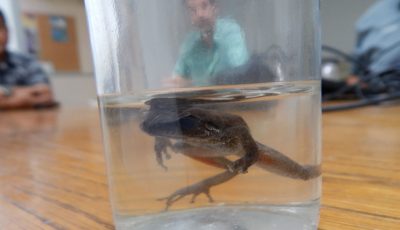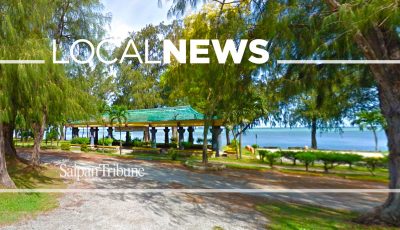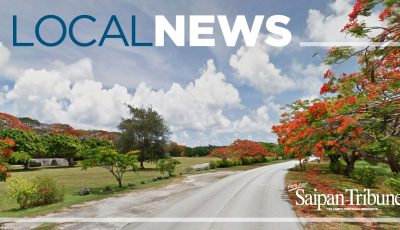DFW, USFWS, Pacific Bird Conservation team up to save birds
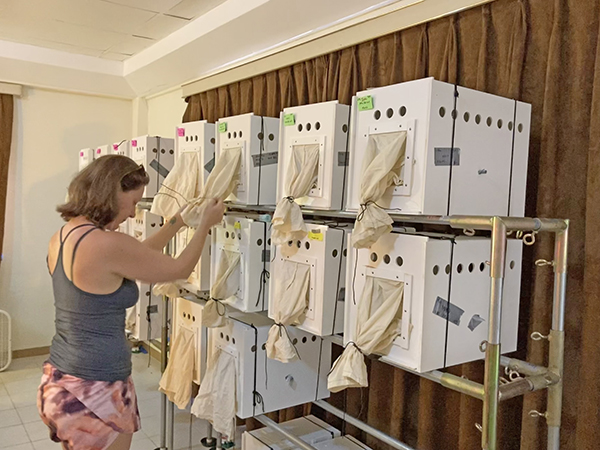
Pacific Bird Conservation veterinarians and vet technicians look after the Mariana Fruit Doves that were caught and placed inside these home enclosures to get them ready to be translocated to the island of Guguan. (Iva Maurin)
In the last seven decades, brown tree snakes practically decimated almost all of the native bird population in Guam, wiping out nine of 11 of the island’s native forest birds, putting at risk the health of its forests, along with the many species that depend on the habitat.
Imagine how it would be if this also happens to birds in the CNMI.
Currently, the CNMI has a very robust Brown Tree Snake program run by the CNMI Division of Fish and Wildlife under the Department of Lands and Natural Resources, with traps in seaports and airports and with barriers created and managed where inspections of transportation vessels, cargos, and warehouses are held to detect the snakes.
In addition, taking the lessons from what happened in the ’50s and is still happening in Guam, the DFW also initiated the Marianas Avifauna Conservation program with the U.S. Fish and Wildlife and the Association of Zoos & Aquariums in 2004, with the objective of creating a bio-reserve for native birds to secure them from the threat of brown tree snakes.
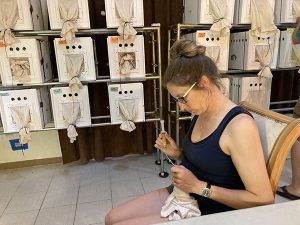
A Mariana Fruit Dove is fed inside the Care Room. Pacific Bird Conservation vets and vet technicians make sure to feed the birds, that they are not stressed, before getting translocated to Guguan. (Iva Maurin)
The MAC program is a long-term bird conservation project directed by the local government, with support from the U.S. Fish and Wildlife Service, and now with the Pacific Bird Conservation, which, for the past several years, has been working with DFW to translocate the islands’ native bird species.
“It’s a 30-year plan,” PBC education coordinator Keri Lammering told Saipan Tribune, “and every year two species of birds are selected to be caught in the wild, brought into human care for about two weeks, and then translocated—moved to an uninhabited island in the northern portions of the CNMI, on the belief that if there’s not a population living there, then there wouldn’t be cargo ships that could potentially bring the brown tree snake.”
The team is currently on island, guided by this year’s mission to translocate the Mariana Fruit Dove (Totot; Mwee’mwe) and the Rufous Fantail (Chichirika; Liteghi par) to the island of Guguan.
DFW supplies all of the field work for the program, and researches and identifies which species are best suited for a particular island.
“They also determine that by releasing those birds on those islands—that they are not affecting the natural populations that already lived there because they don’t want to bring in something that would out-compete [the existing species]. They want to make sure that they don’t affect the natural balance on any of those islands,” Lammering added.
Collecting the birds
PBC comes to the island for three weeks, typically in mid-April to the beginning of May, and for two weeks, to install mist nets in the forests. Lammering explained that mist nets are “really fine nets” that are put up between two poles, “so fine that the birds don’t see it,” and so when birds fly into it, they get caught in the net.
“The keepers, the Pacific Bird Conservation group, they have a system where they check the nets every five to 15 minutes, or if the net is in the full sun, they sit right by them and so they can get birds out immediately—all in the idea that you never want to stress out a bird, overheat it. They want to get it out of the net quickly so they’re able to take the birds out of the net unharmed.”
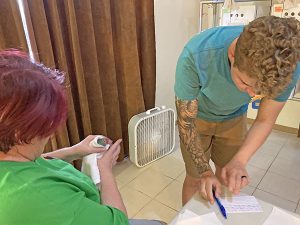
A Mariana Fruit Dove is fed inside the Care Room. Pacific Bird Conservation vets and vet technicians make sure to feed the birds, that they are not stressed, before getting translocated to Guguan. (Iva Maurin)
Non-target species, or birds that are not the target to be caught for a particular year are released. Target birds that are caught are put in transport boxes and are brought to a Care Room, located at the Beach Garden Hotel in Chichirica Ave., Garapan.
“They have a vet and a vet tech that would look the bird over in the wild to make sure that it looks okay, that it’s not showing any signs of stress,” Lammering said. “Then it’s put into the transport box. It only stays in the field for a very short period of time because they want to get it back to the Care Room, and make sure it gets some food and gets into its home enclosure for that remaining time before the translocation.”
The two target birds this year—Rufous Fantail and Mariana Fruit Dove—are sexually-dimorphic, meaning one cannot tell whether they are male or female just by looking at them, so PBC had to measure the birds (wings, various parts of the body) and take tiny little blood sample from underneath their wings, which are sent to the lab to be DNA’d, basically, to identify the sex of the bird.
The measurements are needed so in the future, when they collect birds, they will be able to easily determine males and females before the birds are released.
“We want to make sure that we have a nice mix. We release on an island two times. We have a population that’s released, and then the DFW has biologists that come up to those islands, do a census, and look at how those birds are doing. They’re all banded, and they have different color bands for each year so they can look at the bird and know that ‘oh, that one was released in, like, 2019.’”
Ensuring the birds are safe
The safety of the Mariana birds are of utmost priority—from collection to feeding, from safekeeping to release and translocation. The MAC program still has a long way to end as planned on 2032; however, along the way, adjustments had to be made on species that are being collected.
“This year, we had some readjustment. We were collecting rufous fantails, we had about between 30 and 35 birds. We have done them before and had success with them, but this year, when we had them in our care, some of the birds were showing signs of stress,” Lammering said.
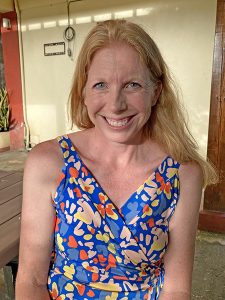
Pacific Bird Conservation education coordinator Keri Lammering is calling on the community to help forest birds through forest restoration work. PBC has partnered with the Mariana Islands Nature Alliance to plant native trees to help the bird population grow in the CNMI. (Iva Maurin)
“It was concerning to the Bird Team. They did not want to harm any of the birds and they still could not quite adjust to get to where the birds were not showing signs of stress. And so they made the hard choice on the benefit of the welfare of the birds to take the 30 that they had and release them back into the wild. All 30 because we didn’t feel comfortable with them doing the translocation successfully.”
Lammering stressed that with the solid goal of not harming any birds, the team decided to just release the Rufous Fantails this year. They are also trying to put all the puzzle pieces together on what happened this year so that hopefully next year or in the coming years, PBC can try collect and move the species again.
“The ones we’re going to translocate this year will be the totot. We have 20 totot that are doing well, not showing any signs of stress, the weights are maintaining or gaining, and so they feel very confident moving those to Guguan as the targeted island this year.”
Success rate
The MAC program has been doing very well, according to Lammering, adding that when they do census work, they see the birds are doing well. “They’re finding un-banded birds, which means they’re happy, they’ve had babies. Everything so far as is going very nicely.”
In addition to the translocation program, PBC is also working to have a deeper engagement with the local community. They are providing micro internships with high school students, have field trips for high school students to see the work being done, and are working with the Public School System. PBC has also partnered with the Mariana Islands Nature Alliance.
“There’s this big effort to put back native trees and so we’re partnering with MINA who does that restoration work. MINA does so much forest restoration work. That’s another thing that these birds desperately need because so many non-native or invasive plant species were put onto this island.”
“If people want to help forest birds, they can contact MINA on best ways to obtain native trees that they can either plant in their yards, or work with their schools and plant native trees around their schools to give that nice habitat for the birds,” Lammering added.
PBC was set to translocate the Mariana Fruit Doves to Guguan last Tuesday, May 3.
For more information about the MAC program, visit the DFW office in Lower Base, or their website, http://www.dfw.gov.mp/Wildlife/MAC_Project.html; or visit www.pacificbirdconservation.org, https://www.facebook.com/PacificBirdConservation.



